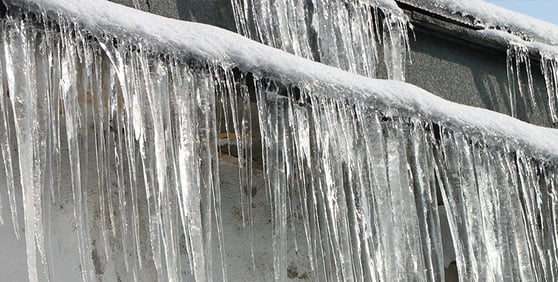
Cold weather brings snow and ice in Iowa, and it’s time to start thinking how to protect your home and roof from the adverse weather. Although the soft falling snow and those long, sparkling icicles on your house may seem beautiful, they can leave behind severe damage if not properly addressed.
When snow collects on your roof and melts, water flows downward and can freeze around your gutters, chimney, skylights, or other low angles of your roof. This forms large icicles, more commonly known as ice dams. If not prevented or removed, the water can cause damage to both the exterior and interior of your home.
Ice dams are a big problem for homeowners, but it is a fairly common issue that can be prevented. The best way to combat an ice dam is to find the source of the problem. Here are three tips on what to look for and how to get ahead of ice formation.
Seal Air Leaking to Your Attic
Heating your home in the winter should allow warm air to circulate throughout the house but avoid overheating your attic. Warm air that reaches the roof causes the snow to melt and begin forming ice dams. Make sure warm air isn’t leaking to the attic by sealing holes, and ensure the flashing between the chimney and roof is working properly. This article explains more if you need to replace your chimney flashing.
Maintain Proper Attic Insulation and Ventilation
Insulation
Your roof should remain below 30°F to prevent the melting snow that creates ice dams. To achieve this, your attic insulation needs to keep warm air from the home away from the roof. Ensure that the insulation on the attic floor and spaces between the rafters has not deteriorated. Other areas to check insulation are the attic door hatch, heating ducts, vent fans, and recessed ceiling lights connected to the room below. Any space emitting heat to the attic should be properly insulated and sealed.
Ventilation
Another way to prevent warm air in the attic is to make sure it ventilates properly. Good attic ventilation allows the air to be distributed evenly and also creates numerous other benefits, including good air quality. Many homes lack proper ventilation systems, and the common solution is a better soffit system. The ventilation system impacts multiple areas of your home, so a professional inspection can help determine what type is right for you.
Install Heat Cables
A long-term tactic for ice dam prevention is installing heat cables. The cables are installed in strategic patterns across the areas of your roof susceptible to pooling water and create warm channels that allow the water to escape your roof’s surface before ice forms. Heat cables can last for several years, so they are a good approach if ice dams are a recurring issue for you.
If you're considering heat cables, know that they run on electricity and will impact your energy bill. Self-regulating heat cables are energy efficient and can be turned on and off to reduce waste. Learn more about heat cable options and tips here.
Use these three practices to explore the source of your ice dam formation and get ahead of the issue as soon as possible. Investing the time and energy into ice dam prevention can save you the stress and expense of repairing leaks, mold, and roof damage.
You can always consult a professional like Hedrick Construction for additional ice dam prevention options or advice on what to do if you already have ice dams. We provide roof repair, ice dam prevention, and other home services in Ankeny, Des Moines, Huxley, and Ames. Feel free to give us a call at 515-597-7663, or contact us by clicking the button below.








Comments